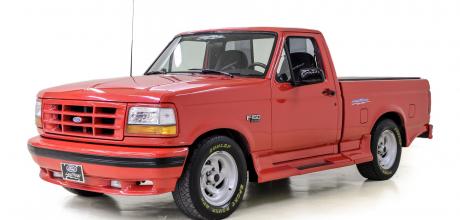Classic - 1993 Ford F150 XLT Lightning

Ford SVT’s original hot rod pick-up from the Nineties still measures up, says Evans…
Ford’s big announcement recently was the launch of its all-electric half-ton pick-up. As seems to be practice these days, the Blue Oval is dusting off iconic emblems from the past and applying them to new battery electrics, in the hope that these vehicles will win some street cred. And after the Mustang Mach-E last year, the new electric F-150 is called, wait for it… Lightning.
From an enthusiast standpoint, this new Lightning is about as far removed from its predecessor as you could get. Granted, it does have a wallop of torque at zero rpm, thanks to twin electric motors, but it’s designed as an everyday vehicle, not a limited production hot rod.
The original F-150 Lightning was a poster child for the revived muscle truck segment in the Nineties. In its first incarnation (1993-95), it was a short box, regular cab, two-wheel drive F-150, powered by a fuel-injected 351cu in (5.8-litre) V8. While that in itself wasn’t particularly special (in fact, if you were savvy with the order sheet back then you could configure any F-150 like this), it was what Ford’s Special Vehicle Team of engineers did with the truck that set the Lightning apart.
First off, the engine received a new Ford Motorsport GT40 style intake assembly; upgraded cylinder heads with larger intake and exhaust valves, special tubular exhaust manifolds that fed into a true dual exhaust system, higher capacity injectors and fuel pump, plus special high-silicon pistons and a unique camshaft. Combined with a special, upgraded ignition system and recalibrated engine electronics, the result was 240bhp and 4200rpm and a healthy 340ft-lb of torque at 3200 revs.
This was transmitted through a four-speed E40D electronic overdrive automatic transmission to an 8.8in rear axle with stout 4.10:1 gears. Acceleration was fairly brisk – with a good driver at the wheel, a 1993 Lightning could hit 60mph in around seven seconds (though bear in mind the thing weighed around 4500lb so it was no bantam). Quarter-mile times in the mid-15s were easily possible too, and about the same as a contemporary Mustang GT in factory tune. Rolling stock was mostly standard F-150 fare, including Ford’s interesting I-beam independent front suspension; solid rear axle suspended on leaf springs and front disc/rear drum brakes. Upgrades included a 1in front and 2.5in rear lower ride height, aided by specific coil springs at the front and unique rear leaf springs out back with special traction bars to aid standing start acceleration; 1in front and rear stabiliser bars; special Monroe GP gas dampers and unique 17in x 8in alloy wheels shod in Firestone Firehawk rubber. All Lightnings received an almost monochromatic exterior finish, with body-coloured bumpers and grille, though black was featured for the bumper inserts, exterior mirrors and window surrounds. Special Lightning graphics were also featured on the rear box sides and tailgate. First year models were offered in just two colours, Raven Black or Bright Red – Oxford White was added for 1994 and continued for the truck’s final season in 1995. Inside, special instrumentation and unique bucket seats could be found, which even today rank as some of the best factory chairs ever installed in a pick-up. By the standards of the time, not only was the Lightning quick in a straight line, it also cornered far better than most pick-ups thanks to the fat tyres, a lower centre of gravity and suspension tweaks. Ford ended up producing 11,536 copies of the original F-150 Lightning over three model years – which was very limited considering the millions of regular F-Series trucks being churned out during the same period. A second-generation Lightning arrived in 1999, essentially based on the same basic formula but adding a 5.4-litre supercharged overhead cam V8 and a great deal more sophistication. Although it made more power and was faster in a straight line, it lacked the same driving dynamics and intrinsic charm that characterised the first-generation version. Today, hot trucks are all about off-roading and pre-runner based performance, with massive tyres and even bigger suspension travel. That’s why something like the Lightning, which was a lowered, street-focused hot rod pick-up that could still take a corner or two and tow a decent trailer behind it, now represents a unique phenomenon. Good examples can still be picked up (sorry, pun intended) for under $20,000 – far less than the cost of the new all-electric Lightning and limited production ensures that you’re not often likely to come across another. Yes, the new electric Lightning might be getting all the attention, but for half the price and a great deal more driving fun, my money’s on its ancestor – the quintessential factory muscle truck of its time.

